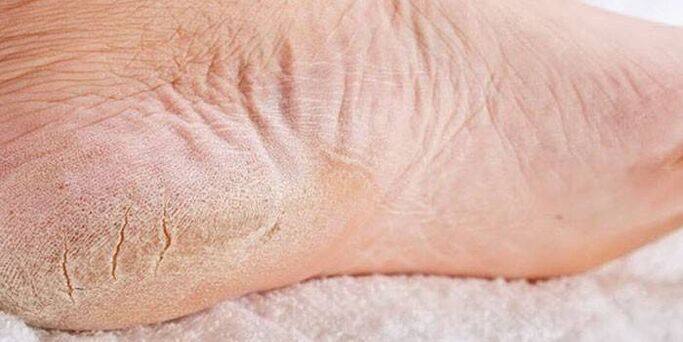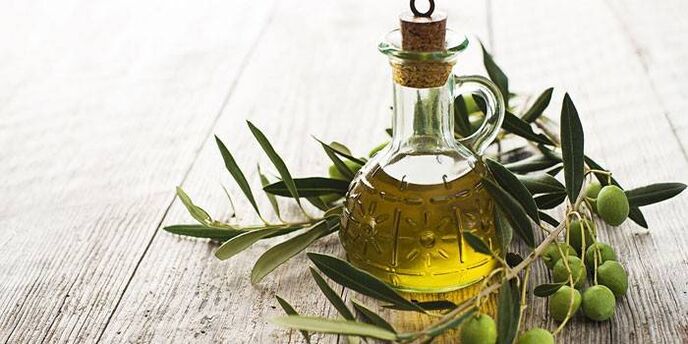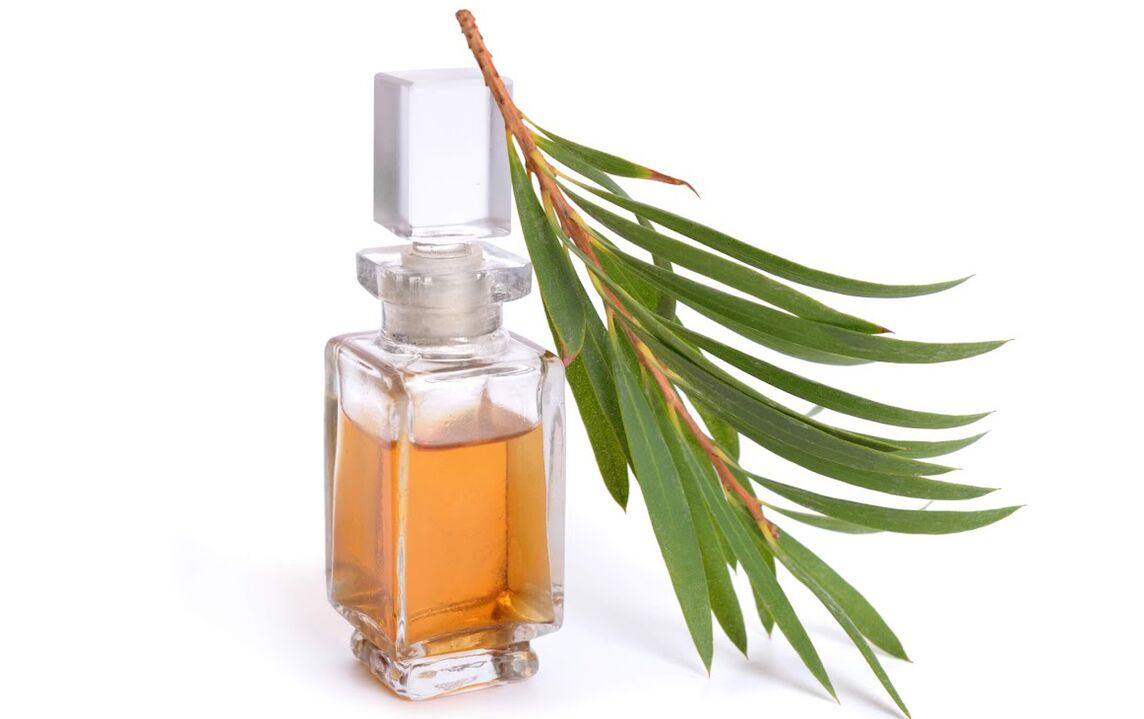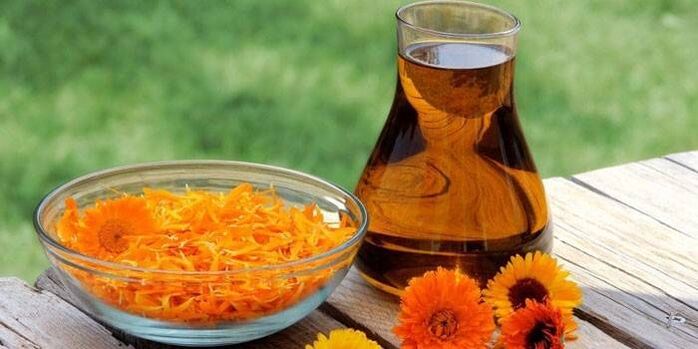One of the most common pathologies of the feet and toenails is fungus. Treatment for this disease takes a long time because getting rid of a fungal infection is not easy. In addition to drug therapy, folk remedies are used, which give excellent results even in advanced cases. In the early stages of the disease, you can use natural recipes at home to cure the infection yourself.
What is athlete's foot and ways of infection
Mycosis or dermatomycosis is an infectious lesion of the skin of the legs, interdigital areas, fingers, nails. A predominant fungal infection of the foot occurs in cultures in which it is common to usually wear closed-toe shoes. More often, the disease affects the elderly and people with weakened immunity due to a serious pathology (immunodeficiency, pemphigus, diabetes mellitus, circulatory disorders in the limbs and others).
The pathogens causing the fungal infection parasitize in the stratum corneum of the skin. They produce enzymes that break down keratin. Their cell walls (membranes) contain mannan substances that suppress local immunity and contribute to the development of a chronic inflammatory process on the skin. Among the many pathogens causing mycosis, the most important are Trichophyton rubrum, Trichophyton mentagrophytes, and Epidermophyton floccosum.
You can become infected with a fungus in two ways: directly or indirectly. The first variant of infection offers several versions:
- close contact with a sick person;
- Contact with an infected animal;
- through the plants with which the sole comes in contact;
- through the soil in which the pathogen lives.
An indirect route of infection with mycosis of the foot occurs:
- when using household items or personal care products of a sick person;
- when using objects that have been touched by an infected animal.
Symptoms of the disease
Depending on the type of fungus, specific symptoms of the disease are distinguished. For example, dermatophytes do not show up for a long time, at which point they penetrate deeply into the layers of the skin or under the nail bed. If the causative agent of mycosis is trichophytosis, the signs of infection are immediately visible - a yeast-like microorganism causes inflammation of the nails and skin and quickly destroys tissues. Without laboratory tests, it is difficult for even a skilled dermatologist to tell what type of infection a patient has.
Common symptoms of athlete's foot appear at an early stage of the disease:
- Cracks in the sole;
- Itching, burning, dryness, peeling of the skin;
- unpleasant foot odor;
- Discoloration and brittle nails;
- shiny skin surface;
- Thickening and reddening of the epidermis;
- increased sensitivity of the sole;
- the appearance of fluid-filled bubbles at the site of inflammation.

Forms of fungal infection
External manifestations of the fungus depend not only on the type of pathogen, but also on the degree of involvement in the inflammatory process of the skin, nails and hair on the legs. Dermatologists differentiate between the following forms of foot mycosis:
- Squamous cell carcinoma (scaly). In the initial stage, redness and peeling of the skin are observed. The affected areas have different areas.
- Hyperkeratotic stage. Severe roughness of the sole, deep cracks in or near the heels. Both legs are affected at the same time.
- Intertriginous form. It is considered the most common. Affects the area between 4 and 5 toes, develops less often between 3 and 4. Cracks are replaced by erosion, which begins to get wet, itching and burning occur. Streptococci invade the loose tissue structure and cause pustular inflammation.
- Dyshidrotic form. Watery bubbles that appear on the epidermis merge. After they are hidden, extensive ulcers develop. Mycosis spreads to the hands.
Treatment of athlete's foot with folk remedies
All folk remedies for athlete's foot have several tasks: destroying the fungal mycelium, eliminating symptoms of inflammation, restoring the integrity of the skin, increasing local immunity, preventing relapse of the disease. For these purposes, decoctions and infusions for oral administration, as well as solutions, ointments and compresses for external use, are used.
Numerous plants, minerals, chemical compounds (copper sulfate) and even gunpowder have antifungal properties - this has been proven by scientific research. More than 1000 names of flora representatives have been identified that have pronounced fungicidal and antifungal effects. The composition of such plants includes benzoic and salicylic acids, furocoumarin, novoimanin and other substances that have a therapeutic effect on fungal infections.
Rules and principles of treatment
Before starting to treat athlete's foot with folk remedies yourself, it is necessary to consult a doctor to prevent further development of the pathology. It is very difficult to cure advanced mycoses. If a few days after the start of using one or another method of positive dynamics did not appear, you should consult a doctor.
There are many popular recipes that are based on the use of herbal and natural ingredients. Treating athlete's foot at home is recommended before bed to allow time for the medication to work. Regardless of the chosen method of eliminating mycosis, you need to adhere to the basic rule: carry out therapy not only until the symptoms completely disappear, but also for some time afterwards. During therapy it is necessary:
- follow a low-sugar diet, that is, remove sweet, starchy foods from the daily menu;
- exclude the use of cosmetic varnishes that create a favorable environment for pathogenic bacteria to multiply;
- perform regular iodine treatment on nail plates affected by a fungal infection (with onychomycosis);
- Disinfect floors and shoes to prevent relapses.
Foot bath for mycoses of the feet
In the early stages of the disease, therapeutic foot baths are very helpful in relieving symptoms. Traditional medicine offers many of the ingredients that these treatments are made from. These are decoctions and infusions of herbs (celandine, wormwood, yarrow, oak bark and others), vinegar, soda and other components. Fight infection daily with trays and soaking your feet in a warm, freshly made solution for 15-20 minutes.
The average duration of treatment for adults is 2 weeks, but the procedure can be carried out longer if necessary. Foot baths not only help stop the fungus from growing, they also help get rid of unpleasant odors and eliminate excessive foot sweating. With proper hygiene of the lower extremities, the positive effect becomes noticeable within a few days after the start of treatment. Examples of trays that can be easily made at home to get rid of athlete's foot:
- Take 3 liters of warm water, stir in 200 g of sea salt. For efficiency, you can add ground cinnamon (1 tablespoon), a decoction of chamomile or pine needles (250 ml).
- Pour warm water into a basin, add 50 ml table or apple cider vinegar and some potassium permanganate granules. After the procedure, smear the affected skin with tea tree oil.
Compresses and lotions
In the case of home complex therapy for mycosis of the foot, it is advisable to use compresses or lotions. Celandine oil, garlic, onion, alcoholic tinctures, iodized salt, and peppermint are used for these procedures. Kombucha, pumpkin pulp, fresh burdock leaves are applied to sore spots. The selected substances are crushed, applied to the area between the toes and on the feet for 40-50 minutes and wrapped in a plastic bag (cling film) on top. The course of treatment is 1-2 times a day until full recovery.
Essential oils and natural pastes
Effective home treatment for athlete's foot with natural plant and essential oils. An extract from tea tree (soothes the skin, relieves itching), lemon (strengthens the nails, increases local defenses), cinnamon (prevents the multiplication of fungi), rosemary (tissue regeneration) has proven itself. Therefore, an effective natural antiseptic oil of lavender, which has an analgesic and wound healing effect, eliminates the symptoms of mycosis much faster than other folk remedies.
You can apply the essential oil in its pure form (after an allergy test) or make natural pastes by mixing a few drops with any vegetable oil (coconut, cocoa, olive, jojoba). Manipulations must be carried out three times a day for several weeks. If the nails are affected by mycosis of the feet, then such treatment lasts until the plate is completely renewed (several months).

Herbal decoctions and tinctures
The popularity of medicinal herbs in treating fungal infections is due to their high potency and availability. Herbal medicine is used not only to get rid of the fungus but also to prevent infection. The main methods of treating mycoses at home are the use of tinctures (infusion of medicinal herbs with ethyl alcohol), decoctions (herbs are heat-treated by languishing in a steam room so as not to boil) and infusions (herbs are poured with boiling water) and infused).
The type and duration of therapy depends on the age of the patient, the accompanying illnesses and the severity of the symptoms. Average duration of use: 2-3 times a day for 14-30 days. The most effective antifungal herbs for treating fungal infections are:
- Birch buds;
- cold mint;
- Aloe;
- Eucalyptus;
- Walnut leaves;
- Chamomile medicines;
- Japanese sophora;
- Puppeteer;
- Celandine;
- Runnik;
- Kalanchoe;
- common juniper.
How to cure athlete's foot at home
Traditional methods of getting rid of the fungus have proven effective. In order to forget about mycosis of the feet forever, it is necessary to properly care for the area of the foot during and after the treatment. For a quick recovery you will need:
- thoroughly dry the skin after bathing;
- wear only dry and clean shoes;
- do not overheat the legs, avoid profuse sweating;
- wear open toe sandals in warm weather;
- wear socks made of natural fabrics with high air permeability and hygroscopicity;
- Always wear personal slippers when showering in a public place.
Practical tools and products in the kitchen
It is easy to find folk remedies at home to get rid of the fungus. Every housewife has a cure for mycoses among the tools available in the kitchen or in the refrigerator. The cheapest:
- Coffee. In this case, the aromatic drink is for external use. Regular foot baths with freshly brewed strong coffee will help manage the disease.
- Garlic. There are many ways to use the plant, but the simplest one is garlic juice rubbed into the affected tissue. The procedure is done with a cotton swab 3 to 5 times a day until the symptoms go away.
- Onion. Fresh onion gruel must be placed in a plastic bag that is worn on the foot. The edges of the bag must be tied so that the bow does not touch the sole and the leg is in a spontaneous steam chamber all night. Usually 5 sessions are enough to get rid of athlete's foot.
Pharmacy traditional medicine
If you do not have time at home to look for a remedy for athlete's foot, you can buy an effective medicine of natural origin from a pharmacy. Among them:
- Potassium permanganate. Popularly known as potassium permanganate, it is effective for treating mycoses. To solve the problem, it is necessary to apply a compress soaked in a solution of potassium permanganate to the leg every night until the problem goes away.
- Iodine. The skin areas affected by the fungus are treated twice a day with a 5% alcohol solution. A contraindication for such a treatment is the high sensitivity of the skin and the individual intolerance of the ingredients.
- Iodine. In onychomycosis, a universal blue solution is used to soften the nail plate, which has become very coarse. Jodinol is used to wipe tissue affected by the fungal infection 2 to 4 times a day.
- Propolis. Alcohol tincture is often used to treat mycoses. You can make a homemade solution by infusing propolis with vodka or alcohol, but this will not affect its effectiveness. For the treatment and prevention of fungi, you need a cotton swab soaked in tincture, which you apply to the infected area and let dry completely 1-2 times / day.
- Ammonia. A tablespoon of the product should be diluted in a glass of distilled water, then soak the fabric with the resulting solution, wrap the feet, fix with adhesive plaster and withstand the compress overnight.
- Boric acid. For antifungal therapy, you need a powder, which after steaming is sprinkled on the feet in the correct dose and socks put on over it. The procedure is carried out every evening. Boric acid is left to stand overnight.
Herbal medicine for mycoses of the feet
Some plants are a natural antibiotic, while others have a complex effect on the affected area. To treat mycoses, poisonous herbs are often used, ingestion of which is unacceptable. The destruction of membrane cells of pathogenic fungi occurs due to an aggressive plant environment, which leads to the rapid neutralization of pathology. Potent herbs include:
- black nightshade;
- cheremitsa;
- male fern;
- Darkening Lumbago.
Effective folk remedies for athlete's foot
In order for folk remedies for mycoses to help, the treatment process should be properly organized. Before starting any procedure, it is necessary to steam your legs, trim off the overgrown nails, grind loose tissue, and remove rough and dead skin. Only then can folk recipes be used successfully. Natural ingredients not only completely destroy the fungal infection, but also give the nails and skin a healthy appearance. The most effective folk remedies should be discussed in more detail.
Garlic compresses
An old home remedy for athlete's foot are garlic compresses. The effectiveness of this simple and inexpensive method lies in the composition of the plant. In addition to vitamins, carbohydrates, and proteins, garlic contains ascorbic acid, which is harmful to harmful microorganisms. You should be aware that if you use garlic compress imprudently you can burn your skin. For this reason, during treatment it is necessary to strictly adhere to the dosage and duration of therapy. Garlic compress recipe:
- Melt 50 g butter, add 1 clove of garlic, 2 tbsp. l. coarse rock salt and mix thoroughly;
- apply the resulting mass in an even layer on sterile gauze and apply to the affected areas for 1 hour.
- treat with a compress several times a day, keeping the limbs motionless during the procedure;
- the recommended duration of treatment is 1 month.
vinegar
You can fight mycoses with any vinegar essence: wine, apple, rice, malt, or sugar cane. The principle of action of vinegar is the penetration of its substances into the infected tissues and the destruction of the cell membranes of the fungus. Mycosis does not develop under the influence of an acidic environment, since colonies of pathogenic microflora die under its influence. In the initial phase of treatment, a low concentration of vinegar (from 3%) should be used, which increases gradually.
Before treatment with this method, the infected area of skin must be checked for abrasions and cracks so as not to cause inflammation or burns to the epithelium. If they are not there, you can use the vinegar compress:
- stir until smooth 2 tbsp. l. nine percent vinegar, 1 tbsp. l. Glycerin and 2 tbsp. l. Vodka;
- dip pieces of bandage in the finished mixture and apply it to the localization site;
- After the bandage dries, re-moisten the bandages in the medicinal mixture.
- the time of using compresses should not exceed 1 hour / day;
- Course duration - 2 weeks.
baking powder
Treating athlete's foot with baking soda at home gives good results. At the first suspicion of a fungal infection, it is necessary to use sodium bicarbonate (sodium bicarbonate), which lowers the acidity of the epidermis. In addition to having an antiseptic effect, baking soda softens the skin and nail plates so that medication can penetrate more easily after use. Under the influence of alkali, the affected tissues become more susceptible to the effects of any other treatment.
For mycoses, soda can be dry, diluted with water and used in combination with other natural or unnatural ingredients. With onychomycosis, soda paste is more effective. To prepare it you need:
- 3 TBSP. l. Soda mixture with 1 tbsp. l. Water until a thick and homogeneous mass is formed;
- then soda paste should be applied to the affected nail to avoid contact with the skin;
- after that, the mass must be acidified with freshly made lemon juice, which immediately reacts with soda;
- the solution must be removed 5-7 minutes after application and wash your feet with soap;
- The procedure is carried out every day before bedtime until the condition of the nail improves.
Tea tree oil
Tea tree oil has been used in dermatology for more than a dozen years as it has established itself as a highly effective remedy for skin conditions. The natural composition of the essential fluid determines its cytotoxic activity, that is, the ability to fight pathogenic microorganisms. Treatment options vary depending on whether the infection is the skin or the nail.
You can heal the nail plate by dripping 1 drop of tea tree oil on the affected area every day. It takes about 2 months for the nail to fully recover and strengthen. For treatment on its own, it is best to use a diluted extract. To do this, you need to take vegetable oil (3 parts), mix with essential oil (1 part), shake and apply to the skin 2-3 times a day for 1, 5 months. It is better to regulate the course of treatment with a doctor. As an analog, clove essential oil can be used.

Hydrogen peroxide
In the fight against fungal infections, hydrogen peroxide helps, which is considered the best antiseptic with a pronounced antibacterial effect. The drug is widely used to treat mycoses, both in medicine and at home. Hydrogen peroxide does not accumulate in the body, so the development of allergic reactions is excluded. For mycoses, baths are effective, helping to soften the affected epithelium for the further flow of antifungal gels, ointments, creams, or sprays prescribed by a doctor.
Making a hydrogen peroxide foot bath at home is easy:
- pour warm water into a basin and add a 3% preparation in the amount of 100 ml per 2 liters of water;
- lower your feet into a container and hold it for 20 minutes;
- so that the solution does not cool, it is necessary to add small portions of boiling water;
- after the procedure with a pumice stone, remove the softened tissues;
- remove moisture with a sponge and apply the prescribed drug to the surface of the skin;
- Do the baths daily until the condition improves.
Laundry or tar soap
For more than a dozen years, people have been cured of fungal infections at home with the help of tar or laundry soap. By observing the rules of treating the affected skin, you can quickly get rid of itching and unpleasant foot odor. To accelerate tissue healing, you need to combine soap with salt or iodine. The following recipe will help improve blood circulation in tissues:
- steam your legs in warm water before going to bed;
- then lather thoroughly with laundry soap;
- treat soapy feet with a washcloth, then with a pumice stone;
- then wipe dry, grease with cream;
- Treat areas of infection with a fungus with birch tar;
- Soak for 1. 5 hours, then remove with cotton pads;
- put on clean socks on your feet and do not take them off for 2 days;
- Repeat the process once a week until the problem is resolved.
Salicylic ointment
The main advantage of treating mycoses with salicylic ointment is its high antifungal activity. The drug kills pathogens, prevents them from multiplying, eliminates the keratinized layers of the epidermis, and rarely causes side effects. With mycosis of the legs, apply salicylic ointment in the form of compresses. On the softened skin or nail plate, the drug is applied in a thin layer at a concentration of 5 or 10%, after which the leg is placed in a plastic bag and socks are placed over it. The procedure lasts 1 hour 2 times / day for 10 days.
Propolis
As mentioned earlier, propolis is effective as a tincture for mycoses. The alcohol component also has a positive effect on pathogenic microorganisms. It is possible to make an ointment with a beekeeping product, which must be rubbed into the affected areas overnight for 10-14 days. His recipe is simple:
- Mix 20 g of crushed propolis (without wax) and 100 g of sea buckthorn oil;
- heat the ingredients in a water bath for 30 minutes;
- Let the mixture cool, strain through a cheesecloth, use as directed.
Celandine and chamomile
Medicinal herbs, especially chamomile and celandine, are believed to be the quickest to get rid of a fungal infection. It is better to use them together. To get a quick effect, you need to drink chamomile broth or tea (to increase general immunity) and take baths with celandine infusion. You should know that the latter's fresh juice is burning, so in its pure form it should be used with extreme caution.
Crushed stems of a dried plant are required for the infusion. In a glass of boiling water, you need to brew 1 tbsp. l. Celandine, leave on for 1 hour, then dilute with a little hot water. With mycoses, the solution is used for therapeutic baths, which are carried out for 15 minutes a day. As a rule, such treatment relieves the initial stage of the disease in 14 days.
Infusion of marigolds
The flowers of this plant contain a large group of biological substances that have powerful antimicrobial effects. Calendula infusion copes with onychomycosis particularly quickly. Before using the drug, it is necessary to steam and work on the nails. After mechanically cleaning the nail plate from fungal plaque and dead tissue, it is necessary to moisten a cotton swab in the infusion and apply it to the affected area. The procedure is carried out daily for 4-8 weeks. It is easy to prepare the product at home:
- Pour a glass of boiling water over 1 tbsp. l. dry or fresh marigold flowers;
- do not insist in a water bath for 10 minutes;
- cool, strain, store at a temperature not exceeding 4 ° C.

Attention! The information contained in the article is for informational purposes only. The materials of the article do not require self-treatment. Only a qualified doctor can make a diagnosis and give treatment recommendations based on the individual characteristics of a particular patient.



























